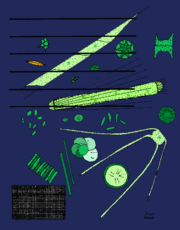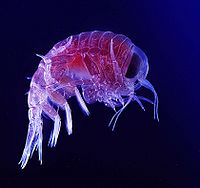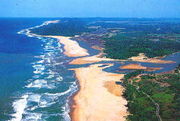Phytoplankton

Phytoplankton are the autotrophic component of the plankton community. The name comes from the Greek words φυτόν (phyton), meaning "plant", and πλαγκτός (planktos), meaning "wanderer" or "drifter".[1] Most phytoplankton are too small to be individually seen with the unaided eye. However, when present in high enough numbers, they may appear as a green discoloration of the water due to the presence of chlorophyll within their cells (although the actual color may vary with the species of phytoplankton present due to varying levels of chlorophyll or the presence of accessory pigments such as phycobiliproteins, xanthophylls, etc.).
Contents |
Ecology


Phytoplankton obtain energy through the process of photosynthesis and must therefore live in the well-lit surface layer (termed the euphotic zone) of an ocean, sea, lake, or other body of water. Phytoplankton account for half of all photosynthetic activity on Earth.[2] Thus phytoplankton are responsible for much of the oxygen present in the Earth's atmosphere – half of the total amount produced by all plant life.[3] Their cumulative energy fixation in carbon compounds (primary production) is the basis for the vast majority of oceanic and also many freshwater food webs (chemosynthesis is a notable exception). Since the 20th century, phytoplankton has declined by roughly 1% yearly, possibly linked to warming oceanic temperatures - as of 2010 this means a decline of 40% relative to 1950.[4][5] As a side note, one of the more remarkable food chains in the ocean – remarkable because of the small number of links – is that of phytoplankton feeding krill (a type of shrimp) feeding baleen whales.
Phytoplankton are also crucially dependent on minerals. These are primarily macronutrients such as nitrate, phosphate or silicic acid, whose availability is governed by the balance between the so-called biological pump and upwelling of deep, nutrient-rich waters. However, across large regions of the World Ocean such as the Southern Ocean, phytoplankton are also limited by the lack of the micronutrient iron. This has led to some scientists advocating iron fertilization as a means to counteract the accumulation of human-produced carbon dioxide (CO2) in the atmosphere.[6] Large-scale experiments have added iron (usually as salts such as iron sulphate) to the oceans to promote phytoplankton growth and draw atmospheric CO2 into the ocean. However, controversy about manipulating the ecosystem and the efficiency of iron fertilization has slowed such experiments.[7]
While almost all phytoplankton species are obligate photoautotrophs, there are some that are mixotrophic and other, non-pigmented species that are actually heterotrophic (the latter are often viewed as zooplankton). Of these, the best known are dinoflagellate genera such as Noctiluca and Dinophysis, that obtain organic carbon by ingesting other organisms or detrital material.
The term phytoplankton encompasses all photoautotrophic microorganisms in aquatic food webs. Phytoplankton serve as the base of the aquatic food web, providing an essential ecological function for all aquatic life. However, unlike terrestrial communities, where most autotrophs are plants, phytoplankton are a diverse group, incorporating protistan eukaryotes and both eubacterial and archaebacterial prokaryotes. There are about 5,000 species of marine phytoplankton.[8] There is uncertainty in how such diversity has evolved in an environment where competition for only a few resources would suggest limited potential for niche differentiation.[9]
In terms of numbers, the most important groups of phytoplankton include the diatoms, cyanobacteria and dinoflagellates, although many other groups of algae are represented. One group, the coccolithophorids, is responsible (in part) for the release of significant amounts of dimethyl sulfide (DMS) into the atmosphere. DMS is converted to sulfate and these sulfate molecules act as cloud condensation nuclei, increasing general cloud cover. In oligotrophic oceanic regions such as the Sargasso Sea or the South Pacific Gyre, phytoplankton is dominated by the small sized cells, called picoplankton, mostly composed of cyanobacteria (Prochlorococcus, Synechococcus) and picoeucaryotes such as Micromonas.
Aquaculture

Phytoplankton are a key food item in both aquaculture and mariculture. Both utilize phytoplankton for the feeding of the animals being farmed. In mariculture, the phytoplankton is naturally occurring and is introduced into enclosures with the normal circulation of seawater. In aquaculture, phytoplankton must be obtained and introduced directly. The plankton can either be collected from a body of water or cultured, though the former method is seldom used. Phytoplankton is used as a foodstock for the production of rotifers[10], which are in turn used to feed other organisms. Phytoplankton is also used to feed many varieties of aquacultured molluscs, including pearl oysters and giant clams.
The production of phytoplankton under artificial conditions is itself a form of aquaculture. Phytoplankton is cultured for a variety of purposes, including foodstock for other aquacultured organisms[10], a nutritional supplement for captive invertebrates in aquaria. Culture sizes range from small-scale laboratory cultures of less than 1L to several tens of thousands of liters for commercial aquaculture[10]. Regardless of the size of the culture, certain conditions must be provided for efficient growth of plankton. The majority of cultured plankton is marine, and seawater of a specific gravity of 1.010 to 1.026 may be used as a culture medium. This water must be sterilized, usually by either high temperatures in an autoclave or by exposure to ultraviolet radiation, to prevent biological contamination of the culture. Various fertilizers are added to the culture medium to facilitate the growth of plankton. A culture must be aerated or agitated in some way to keep plankton suspended, as well as to provide dissolved carbon dioxide for photosynthesis. In addition to constant aeration, most cultures are manually mixed or stirred on a regular basis. Light must be provided for the growth of phytoplankton. The colour temperature of illumination should be approximately 6,500 K, but values from 4,000 K to upwards of 20,000 K have been used successfully. The duration of light exposure should be approximately 16 hours daily; this is the most efficient artificial day length[10].
Blooms
 West of Iceland |
 West of France |
||
 Off the east coast of New Zealand |
 Off the coast of Argentina |
||
 Off the east coast of Greenland |
See also
- Algae
- Algae culture
- AlgaeBase
- Bacterioplankton
- Biological pump
- CLAW hypothesis
- Iron fertilization
- Microphyte (microalgae)
- Ocean acidification
- Paradox of the plankton
- Photosynthetic picoplankton
- Plankton
- Zooplankton
References
- ↑ Thurman, H. V. (1997). Introductory Oceanography. New Jersey, USA: Prentice Hall College. ISBN 0132620723.
- ↑ "NASA Satellite Detects Red Glow to Map Global Ocean Plant Health" NASA, 28 May 2009.
- ↑ "Satellite Sees Ocean Plants Increase, Coasts Greening". NASA. 2 March 2005. http://earthobservatory.nasa.gov/Newsroom/NasaNews/2005/2005030218443.html. Retrieved 12 January 2009.
- ↑ "Marine Phytoplankton Declining: Striking Global Changes at the Base of the Marine Food Web Linked to Rising Ocean Temperatures". 2010. http://www.sciencedaily.com/releases/2010/07/100728131705.htm.
- ↑ David A. Siegel & Bryan A. Franz (2010). "Oceanography: Century of phytoplankton change". Nature July 28 (7306): 569. doi:10.1038/466569a. PMID 20671698.
- ↑ Richtel, M. (May 1, 2007). "Recruiting Plankton to Fight Global Warming". New York Times. http://www.nytimes.com/2007/05/01/business/01plankton.html?ref=science
- ↑ See: Monastersky, R.: "Iron versus the greenhouse." Science News, 30 September 1995, p. 220.
- ↑ Hallegraeff, G.M. (2003). Harmful algal blooms: a global overview. in Hallegraeff, G.M., Andewrson, D.M. and Cembella, A.D. (eds) 2003. Manual on Harmful Marine Microalgae. UNESCO, Paris
- ↑ G.E. Hutchinson (1961). "The paradox of the plankton". Am. Nat. 95: 137–145. doi:10.1086/282171.
- ↑ 10.0 10.1 10.2 10.3 McVey, James P., Nai-Hsien Chao, and Cheng-Sheng Lee. CRC Handbook of Mariculture Vol. 1 : Crustacean Aquaculture. New York: C R C P LLC, 1993.
External links
- NOAA, DMS and Climate
- Plankton*Net : Images of planktonic species
|
|||||||||||||||||||||||||||||||||||
|
||||||||||||||||||||||||||||||









